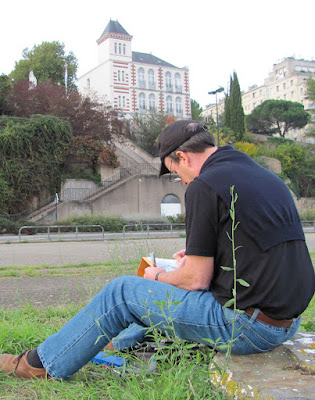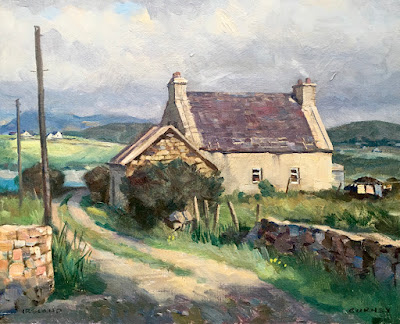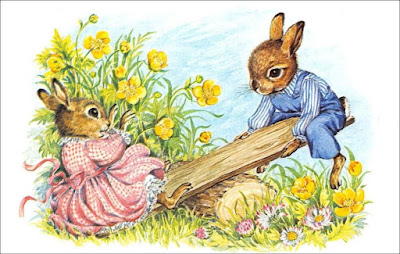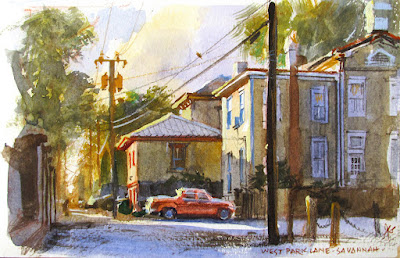Saturday, September 30, 2023
How I Paint a Dahlia in Casein
Painting is about continuously controlling your visual attention so that you see only what you need to see at each stage, and tune out the rest.
I also think about (Link to YouTube) about the remarkable visual perception abilities of bees.
And when honey bees are in flight, their color vision is turned off. The world appears in black and white. But when they approach their target flower, the colors come into focus.
Did you know honey bees have five eyes? In addition to the two large compound eyes located on the sides of the head they've got three small eyes called “ocelli” on top of their head. Ocelli are not used to gather images; instead they are light receptors.
----
Read more in the online article How Bees See Flowers
Labels:
Animals
Friday, September 29, 2023
What I'll Be Doing at Lightbox Expo
I've got a couple appearances coming up at Lightbox Expo in Pasadena next month.
We're kicking it off with the "Colossal Characters" event. Here's more info:

Who: Twelve invited professional concept artists wearing orange caps will lead the event. So far the mentor group includes Michelle Lin, Angela Sung, Aaron Blaise, Wouter Tulp, Marco Bucci, Gary Geraths, me, and four concept artists from Blizzard Entertainment. These mentors who are here because of Lightbox Expo will either demo or help other artists or both.
Who can join in? Any additional artist can join the fun and sketch their concept. Participating artists don't have to be part of Lightbox Expo. They can be any age or any level of skill or experience. Kids are welcome and encouraged. Each participant receives an official sticker or button. Members of the general public can just come to see art being made.
Where: All around downtown Pasadena, but centered around the City Hall.
Why: To celebrate imagination mixed with observation and to see Pasadena in a new, fun way.
Online: Other artists participating online will be sketching colossal characters in their town or city. Their work will appear in a Facebook group page called "Colossal Characters."
Read More: in the Pasadena Events article.
COLOSSAL CHARACTERS
What is it?: An art event where artists drawing or painting on location imagine a giant character visiting Pasadena. The character can come from animation, movies, video games, or comics. The interaction between the character and Pasadena can be anything from playful to apocalyptic.
When: Friday, October 27, 10:00-noon.
What is it?: An art event where artists drawing or painting on location imagine a giant character visiting Pasadena. The character can come from animation, movies, video games, or comics. The interaction between the character and Pasadena can be anything from playful to apocalyptic.
When: Friday, October 27, 10:00-noon.

Who: Twelve invited professional concept artists wearing orange caps will lead the event. So far the mentor group includes Michelle Lin, Angela Sung, Aaron Blaise, Wouter Tulp, Marco Bucci, Gary Geraths, me, and four concept artists from Blizzard Entertainment. These mentors who are here because of Lightbox Expo will either demo or help other artists or both.
Who can join in? Any additional artist can join the fun and sketch their concept. Participating artists don't have to be part of Lightbox Expo. They can be any age or any level of skill or experience. Kids are welcome and encouraged. Each participant receives an official sticker or button. Members of the general public can just come to see art being made.
Where: All around downtown Pasadena, but centered around the City Hall.
Why: To celebrate imagination mixed with observation and to see Pasadena in a new, fun way.
Online: Other artists participating online will be sketching colossal characters in their town or city. Their work will appear in a Facebook group page called "Colossal Characters."
Read More: in the Pasadena Events article.
Wednesday, September 27, 2023
Rossetti's Exotic Pets

Dante Gabriel Rossetti owned a kangaroo, owl, armadillo, llama, and a toucan. He was known for his love of exotic animals and even expressed an impulsive desire to own an elephant and a penguin.
His house at Cheyne Walk, Chelsea, London, also had a white Brahmin bull, monkeys, peacocks, an Australian kingfisher, dormice, a Pomeranian puppy, an Irish wolfhound, hedgehogs, parakeets, chameleons, lizards, salamanders, marmots, a mole, and a raccoon. The raccoon hibernated in a chest of drawers
Rossetti was obsessed with wombats and even had one as a pet. He named it "Top", and it was a regular sight in his home.
Some of Rossetti's exotic pets led to problems with neighbors, who were often disturbed by noise and smells, and by the way the animals were treated.
Sources: Public Domain Review and Magnet Manchester
Sources: Public Domain Review and Magnet Manchester
Monday, September 25, 2023
Sunday, September 24, 2023
Cottage in Connemara
Clifden, Connemara, 8x10” plein-air oil
Saturday, September 23, 2023
Frank Duveneck, American Portrait Painter
Frank Duveneck was an American figure and portrait painter born on October 9, 1848, in Covington, Kentucky. His parents were German immigrants, and his father died when he was a year old. His mother remarried a businessman named Joseph Duveneck, and the artist legally adopted his stepfather's name when he married in 1886.
Portrait of a Woman with Black Hat 1890, Pastel by Frank Duveneck
Duveneck began painting in his early teens and was employed as an assistant to Wilhelm Lamprecht, a successful German-born decorator. At age 21, Duveneck studied in Germany at the Munich Academy with Wilhelm Dietz and was greatly influenced by the works of Frans Hals, Rembrandt, and Peter Paul Rubens.
Friday, September 22, 2023
Audrey Tarrant, Illustrator
She went to the Selhurst Grammer School for Girls. She studied art at the Croydon School of Art. Her artwork has been published in the form of illustrated books and postcards.
Wednesday, September 20, 2023
Yoshida Tōshi's Cherry Blossoms
How many birds do you see in this picture?
Cherry Blossoms by Yoshida Tōshi, 1951 Courtesy Masterpieces of Japan
Tuesday, September 19, 2023
Casein Questions on Open Time and Varnishing

Rollo Q asks: "I have a couple of questions about the casein. Roughly how long do you find the paint is wet (moveable rather than liftable) on the surface. Obviously I realise this must depend on climate and surface and paint thickness etc, but I've seen people call it fast drying and its hard to tell what that means (I paint in flashe vinyl which is notably slower than acrylics but faster by far than oils. Open time is 30 - 60 mins for flashe I'd guess). Also do you use an acrylic varnish? Or a resin?"
James Gurney answers: You're right, time it takes for a freshly painted area to dry to the touch depends on the temperature, humidity, wind, paint thickness and wetness, absorbency of the ground, and even the type of pigment. Cadmiums are slower drying than umbers, for example, and titanium white dries relatively fast. This pigment variable is especially noticeable on the paint blobs squeezed out on the palette.
So how long does it take for a passage to dry? On a nice day an average paint stroke starts to set up in anywhere from a few minutes to ten minutes or so. While it's still wet you can blend all you want, but once it's dry to the touch, a stroke can go down over it without much fear of previous layers lifting or reactivating, unless the new stroke is really wet or there's a lot of scrubbing.
Paint that is newly dry presents a relatively closed surface, meaning that, unlike gouache, it resists reactivation. The strength of the paint's glue-like binder is not as strong as acrylic, which has a powerful bond which sticks hard to your palette and wreaks havoc on your brushes. Because of that weaker binder, casein techniques involving thick, textural impasto should only be painted on a rigid surface such as a panel or illustration board.
With casein, paint that feels dry from evaporation isn't fully cured yet. The milk protein molecules keep bonding, which can take anywhere from overnight to a couple weeks. Curing time can be accelerated by putting the painting in a sunny, dry, and warm (but not too hot) location.
After it's dried and cured you can decide whether or not you want to varnish it. Like gouache, casein is meant to dry matte, and that can look good in a light, high-key painting. I almost never varnish sketchbook paintings. Paintings with a matte surface certainly photograph well, and the digital version of a painting can be adjusted in Photoshop to give it the full range of values. The manufacturers suggest buffing the surface of a dry painting using an old T-shirt to add some semi-gloss luster to the surface.
The main reason I varnish some of my casein paintings is to deepen the darks in an overall dark painting or to protect a painting that I want to frame without glass. Dark-keyed paintings look better varnished, and sometimes varnish is needed to unify the surface sheen of the painting. You can varnish casein just as you would varnish an oil painting. The advantage of casein compared with oil for plein-air painters is that you can varnish it the same day, rather than waiting weeks or months for the paint to dry.
I've tried various brush-on varnishes, but I've been using a non-yellowing spray gloss varnish, which works well, but acrylic gloss varnish should work well, too.
For the varnish to work with one or two coats, the substrate beneath the paint needs to be relatively non absorbent, such as a hardwood panel or gesso-primed canvas mounted to board. I've been painting on acrylic primed canvas panels, which respond well to varnish. If the painting consists of thin casein washes on soft watercolor paper, the surface will absorb the varnish, and it will take a lot of coats before you start to get a glossy surface. After it's varnished, a casein painting can be framed without glass just like an oil.
Here are some links assorted casein paints:
---
Sunday, September 17, 2023
Poppies in Casein
Poppies, painted in casein, will be one of six paintings I’ll have in a botanical art show and sale.
Saturday, September 16, 2023
Painting the Stonecrop Conservatory in Casein
In this new video on YouTube I use casein paint for a plein-air study of the conservatory at Stonecrop Gardens.
As I demonstrate my drawing and painting process, I explain the advantages of casein compared to oils, gouache, and acrylic.
Here are some links for more info about the casein paint I'm using:
---
For information about availability of original art, contact Karen Stein at this email address: garden@stonecrop.org
Thursday, September 14, 2023
Upcoming Article: Painting in Public
Painting in Public is the topic for my next article in International Artist Magazine (#153 Oct/Nov).
Wednesday, September 13, 2023
Skybax Toy Prototypes
Would giant pterosaurs with saddles make cool toys? I did these marker sketches to explore some of the possibilities.
This one-of-a-kind toy prototype was made by Hasbro in 1997, part of a proposal for a line of Dinotopia toys. The skybax is fully posable, with flapping wings, gripping foot claws, and a removable saddle for the Will Denison action figure.
Here's a larger prototype with some plush, soft, and fuzzy elements.

There was a Jurassic Park toy with a remarkable similarity. It's possible that the JP toy came first and that they modded it out for the Dinotopia presentation.
Tuesday, September 12, 2023
Painting Fantasy on Location
What struck me about the exterior of the Jules Verne Museum was the way the historic building sits on the brow of a steep cliff, with a statue of St. Anne atop a long flight of stairs.
So I painted this 7 x 9-inch sketch on location, trying to imagine it separated from gravity on its own journey to another world.

I worked on a separate piece of hot press watercolor paper, using fairly traditional watercolor. After laying in the broad masses of the sky, rock, and architecture, I further defined the details and textures using water-soluble colored pencils. This is a fairly fast way to sketch; the whole painting was finished on location in two and a half hours, but it would have taken me far longer to do the same thing in the studio.
So I painted this 7 x 9-inch sketch on location, trying to imagine it separated from gravity on its own journey to another world.

I worked on a separate piece of hot press watercolor paper, using fairly traditional watercolor. After laying in the broad masses of the sky, rock, and architecture, I further defined the details and textures using water-soluble colored pencils. This is a fairly fast way to sketch; the whole painting was finished on location in two and a half hours, but it would have taken me far longer to do the same thing in the studio.
Monday, September 11, 2023
Artistic License
I was practicing art without a license—until I got this.
This Artistic License was made by Rick Allen of Duluth, a master wood engraver and hand printer. Each license has a unique number and makes three passes through the press, one for each color.
Sunday, September 10, 2023
Spinosaurus Restorations, Step by Step
In this YouTube video, I demonstrate step-by-step process of painting two restorations of the dinosaur Spinosaurus under the direction of Dr. Paul Sereno of the University of Chicago.
Dr. Sereno's scientific paper, called "Spinosaurus is Not an Aquatic Dinosaur," set out to refute claims by other researchers that Spinosaurus was a fast attack hunter underwater. Sereno's team developed a CT-based skeletal restoration of Spinosaurus and examined its hydrodynamic properties. They found that the digital model of Spinosaurus performed very poorly in water, supporting the alternative "semi-aquatic hypothesis." In an interview, Sereno said, "I don't think it was a good swimmer nor capable of full submergence behavior."
Coauthors include Donald M. Henderson, Daniel Vidal, Frank E. Fish, Stephanie L. Baumgart, Tyler M. Keillor, Kiersten K. Formoso, Nathan Myrhvold, and Lauren L. Conroy.
Coauthors include Donald M. Henderson, Daniel Vidal, Frank E. Fish, Stephanie L. Baumgart, Tyler M. Keillor, Kiersten K. Formoso, Nathan Myrhvold, and Lauren L. Conroy.
READ MORE:
Friday, September 8, 2023
Weeds or Wildflowers?
Studying the exquisite geometry of wildflowers (mullein, milkweed, and goldenrod) brings to mind the 1911 poem by Ella Wheeler Wilcox.
THE WEED
A weed is but an unloved flower!
Go dig, and prune, and guide, and wait,
Until it learns its high estate,
And glorifies some bower.
A weed is but an unloved flower!
All sin is virtue unevolved,
Release the angel from the clod--
Go love thy brother up to God.
Behold each problem solved.
All sin is virtue unevolved.
Thursday, September 7, 2023
Fidelia's Backgrounds
Fidelia Bridges (1834-1923) started her career using oil paint, but then switched over to watercolor and gouache. Her chromolithograph prints made her the most popular woman artist of her era.
What I've been looking at is how she set up her backgrounds to allow the viewer to focus on the foreground botanical detail. Here there's a very simple but subtle gradient that gets lighter and warmer toward the bottom.
Although she loved painting botanical studies, she rarely painted her subjects against a white background. Generally she used either toned paper or paper that had been pre-toned by her with a watercolor wash.
A simple blue-to-amber gradient suggests sky-to-high-grass.
Sometimes she gives a little more information in those backgrounds, suggesting here the arching forms of wheat stalks.
---
Read more:
Monograph Fidelia Bridges: Nature into Art by Katherine Manthorne
Wednesday, September 6, 2023
Colossal Character Challenge

What: An art event where artists drawing or painting on location imagine a giant character visiting Pasadena. The character can come from animation, movies, video games, or comics. The interaction between the character and Pasadena can be anything from playful to apocalyptic.
When: October 27, 10:00-noon.

Who: Twelve invited professional concept artists wearing orange caps will lead the event. These mentors who are here because of Lightbox Expo will either demo or help other artists or both. Any additional artist can join the fun and sketch their concept. Participating artists don't have to be part of Lightbox Expo. They can be any age or any level of skill or experience. Kids are welcome and encouraged. Each participant receives an official sticker or button. Members of the general public can just come to see art being made.

Where: All around downtown Pasadena, but centered around the City Hall.
Why: To celebrate imagination mixed with observation and to see Pasadena in a new, fun way.
Online: Other artists participating online will be sketching colossal characters in their town or city. Their work will appear in a Facebook group page called "Colossal Characters Challenge." Deadline for that group is November 1.
There will be another Facebook group for artists working digitally, in CGI, animation, or A.I.
Monday, September 4, 2023
ESP Show
I did this sketch from life of a street performer named Glenn Gazin. He did a mind-reading act in Central Park in New York City, back around 1980.
He perfected his act and used it in the nightclub he owned called "The Dive" on West 29th Street. The Dive hosted comedy acts, techno-pop, one-act plays, and horror movies.
Sunday, September 3, 2023
Call It Mixed Media?
Some call this mixed media because it combines watercolor, gouache, colored pencils and fountain pens.
I don't think of it that way. To me it's all about one thing: putting pigment on paper.
At each stage of the sketch, the pigment goes down whichever way is most efficient. Some touches are wet, broad, and blurry, and some are dry, sharp and dry.
Call it drawing and painting if you want, but to me it's just laying down pigment.
What I was focused on was the sunlight setting just to the left of the alley.
Saturday, September 2, 2023
'Draw What You See...'
When I was in junior high school, my older brother Dan gave me a piece of advice that hit me like a thunderbolt: “Draw what you see, not what you think you see.”
I had been drawing the symbols for the eyes and nose and not really paying attention to the way they actually appeared. This began a sort of obsession for me. I wanted to draw things as accurately as I could, trying to make my eyes work like a camera.
I had been drawing the symbols for the eyes and nose and not really paying attention to the way they actually appeared. This began a sort of obsession for me. I wanted to draw things as accurately as I could, trying to make my eyes work like a camera.
When I was 13 years old, I set up this arrangement——a rocking chair, a broken umbrella, and a couple of boots——and drew it all with a Rapidograph pen from observation. I wanted to enter it in a student art show along with some other drawings for $10 each, which seemed like a lot of money to me. But my bro convinced me to hold off selling it because I might want to have it someday as a milestone of my progress. Thanks, Dan.
Friday, September 1, 2023
Inside Ebulon
What happens inside the mysterious stone monuments of Ebulon?
It's the headquarters of the skybax riders who practice air jousting, an ancient sport where challengers try to knock each other out of their pterosaur saddle. Loser parachutes to the ground.
It's all part of Dinotopia: Journey to Chandara. The Dover edition contains a 30 page afterword that digs into the sketches, maquettes, and reference photos. Signed copies at the link in bio.
Subscribe to:
Posts (Atom)











































